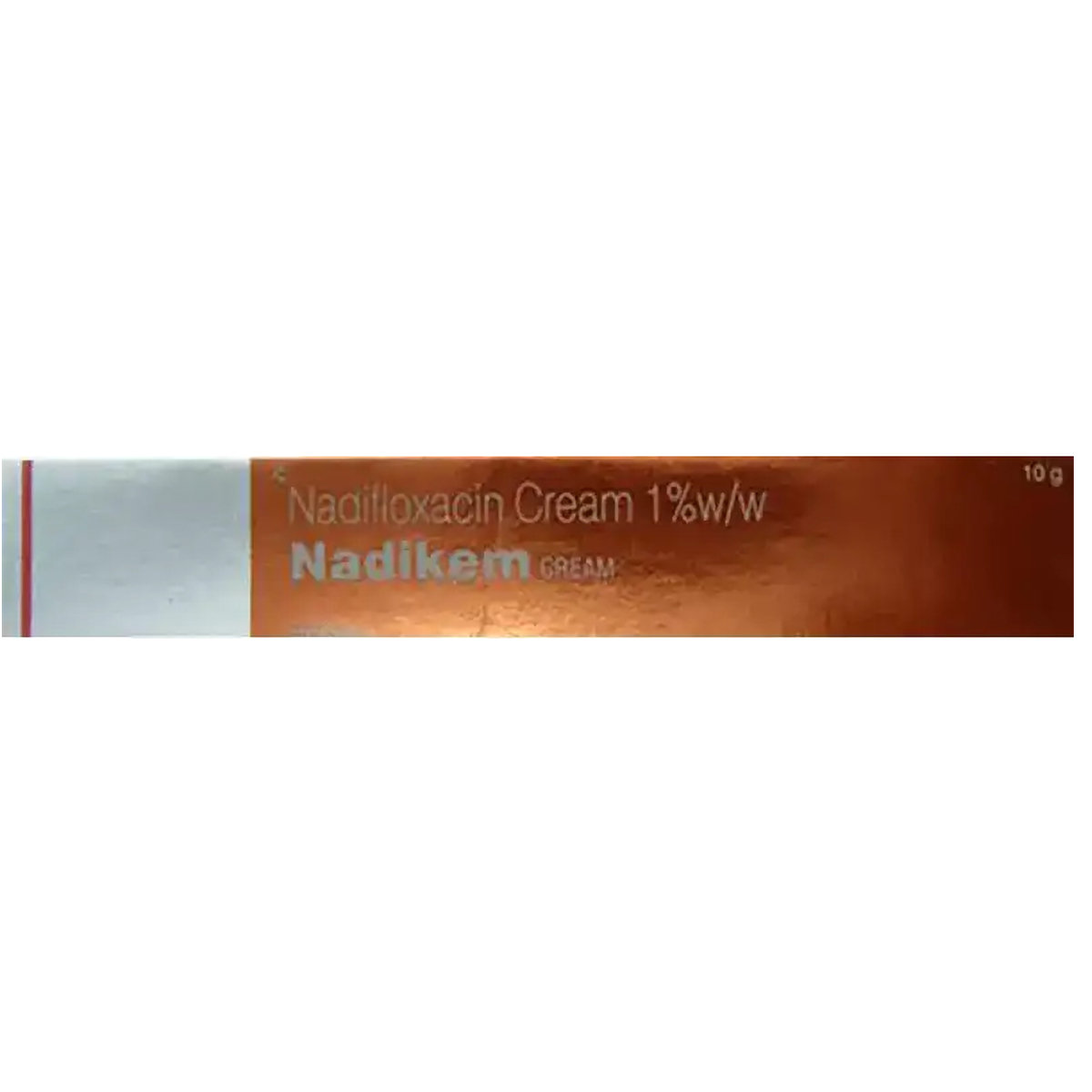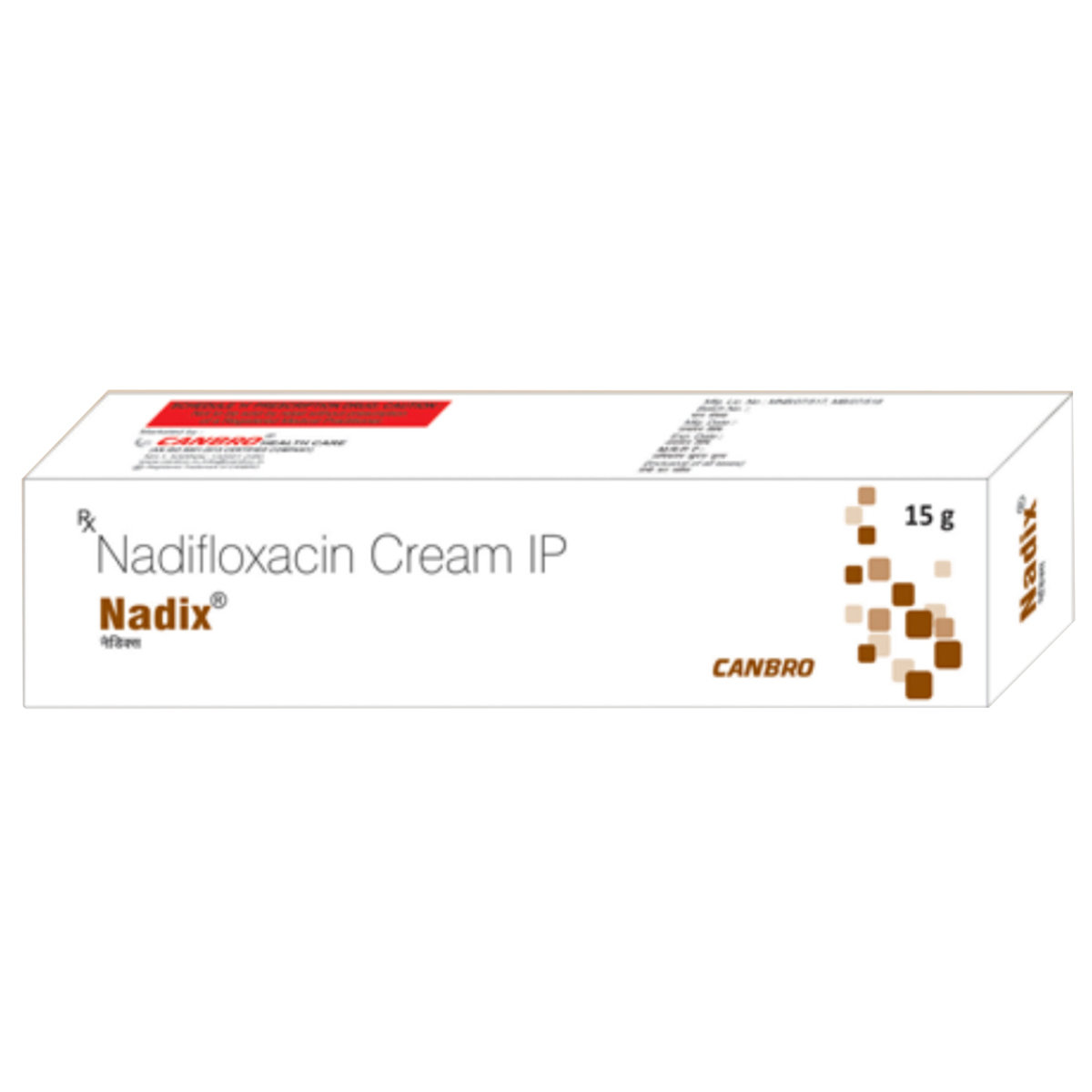- Home
- Nadizee Cream
Nadizee Cream Substitute
Nadizee Cream Substitute
Medicine Composition:
NADIFLOXACIN-1%W/WAll Substitutes & Brand Comparisons
RX
Nadiskin Cream
Hetero Drugs Ltd
₹39.7
(₹3.57/ 1gm)
20% CHEAPERRX
Nadikem Cream 10 gm
Alkem Laboratories Ltd
₹68
(₹6.12/ 1gm)
36% COSTLIERRX
Nadicare Cream
Nanz Med Science Pharma Pvt Ltd
₹75
(₹6.75/ 1gm)
50% COSTLIERRX
Nadiwin 1% Cream
Biochemix Health Care Pvt Ltd
₹125
(₹7.5/ 1gm)
66% COSTLIERRX
Naditop 1% Cream
₹89
(₹8.01/ 1gm)
78% COSTLIERRX
Nadiday 1% Cream
₹146
(₹8.76/ 1gm)
94% COSTLIERRX
Nadimin Skin Cream
Leeford Healthcare Ltd
₹100
(₹9.0/ 1gm)
100% COSTLIERRX
Nadix 1% Cream 15 gm
Canbro Healthcare
₹144.2
(₹9.61/ 1gm)
113% COSTLIERRX
Nadinav Cream 10 gm
Dhamus Pharma
₹121.5
(₹10.94/ 1gm)
143% COSTLIERRX
Nadiderm Cream 10 gm
Abbott India Ltd
₹126.5
(₹11.39/ 1gm)
153% COSTLIERRX
Naditret Cream 10 gm
Klm Laboratories Pvt Ltd
₹128
(₹11.52/ 1gm)
156% COSTLIERRX
Nadibact Cream 10 gm
Cipla Ltd
₹132
(₹11.89/ 1gm)
164% COSTLIERRX
Nadotop Cream 15 gm
S3 BIOTEK
₹202.5
(₹13.5/ 1gm)
200% COSTLIERRX
Nadoxin Cream 10 gm
Wockhardt Ltd
₹184
(₹16.19/ 1gm)
259% COSTLIER

When Should You Consider Switching from Nadizee Cream?
Patients may explore substitutes in the following scenarios:
- High monthly cost of Nadizee Cream
- Non-availability in local pharmacies
- Generic recommendation by a doctor
- Side effects or better tolerability with alternatives
What to Know Before Switching
Before you switch from Nadizee Cream to another medicine, here are some important points to keep in mind:
Same salt, different brands:
Most substitutes contain the same active ingredient - NADIFLOXACIN-1%W/W, but the fillers, coating, or manufacturing quality may vary slightly.
Consult your doctor first:
Even if the salt is the same, your doctor can confirm if the substitute is right for your condition, dosage, and health history.
Watch out for allergies or reactions:
Some people may react differently to certain brands due to inactive ingredients. If you notice any side effects, inform your doctor immediately.
Price ≠ effectiveness:
A lower-priced substitute doesn't mean it's less effective. Many generic medicines work just as well as branded ones.
Check the dosage form and strength:
Always match the substitute’s strength (e.g., 5mg, 10mg) and form (tablet, capsule, syrup) with what your doctor prescribed.
Uses
Nadizee Cream is used in the treatment of bacterial infections. The detailed uses of Nadizee Cream are as follows:
- Bacterial Infections: Nadizee Cream is commonly used to treat various bacterial infections, including respiratory tract infections, skin infections, and urinary tract infections.
- Acne Treatment: Nadizee Cream is effective in managing moderate to severe acne by reducing inflammation and bacterial growth on the skin.
- Anti-Inflammatory Benefits: Nadizee Cream soothes redness and irritation caused by acne lesions, promoting healthier-looking skin.
- Bacterial defence: Nadizee Cream is packed with active ingredients, it targets acne-causing bacteria, reducing the chances of new blemishes.
Medicinal Benefits
Nadizee Cream contains antibiotic Nadifloxacin, which helps treat and prevent a wide range of bacterial skin infections caused by most Gram-negative bacteria, many Gram-positive bacteria, and some anaerobes bacteria (that lives without oxygen) including Cutibacterium acnes and Staphylococcus epidermidis. It is bactericidal in nature and works by killing bacteria that cause infections by prevents the formation of their cell wall required for living. It also inhibits the repairing of bacterial cells. Altogether it kills the bacteria. Nadizee Cream has the advantage of good penetration in most deep tissues. Hence, it is used for bacterial skin infections.
FAQs
The substitutes of Nadizee Cream contain the same active salt(s) - NADIFLOXACIN-1%W/W. However, they may differ in price, manufacturing quality, and inactive ingredients. Speak to your doctor to find a suitable option.
Switching to a generic substitute medicine in the place of Nadizee Cream is often possible if it has the same salt, strength, and dosage form. But always check with your doctor before making any changes to your medication.
Generics versions of Nadizee Cream are typically more affordable because they don’t include the original brand's research, development, and marketing costs. They contain the same active ingredient and are approved for safety and effectiveness.
Most people don’t notice any difference. However, some may react to different fillers or coatings. If you notice any unusual symptoms after switching, consult your doctor.
Make sure the new medicine has the same active salt, strength, dosage form. Always confirm the change with your doctor or pharmacist.
Substitutes of Nadizee Cream meet the same safety and efficacy standards as Nadizee Cream, but small differences in absorption or formulation can exist. A doctor can help you choose the right one for your needs.
Yes. Substitutes of Nadizee Cream may vary in color, size, or shape due to differences in manufacturing and branding, but this does not affect how they work.
Yes, it’s generally safe to switch between multiple substitutes of Nadizee Cream if they have the same salt and strength. However, always inform your doctor so they can monitor how your body responds.
Yes, many people safely use substitutes of Nadizee Cream for long-term treatment. Just ensure it’s done under medical supervision.
If your symptoms stay under control or lab results remain stable, the substitute for Nadizee Cream is likely working well. Regular follow-ups with your doctor are important.
Absolutely. Even with the same salt, small differences can affect how your body responds when switching from Nadizee Cream to its substitute. Always consult your doctor before switching.
Nadizee Cream is used to treat bacterial infections.
Nadizee Cream works by killing bacteria that cause infections. It inhibits the repairing of bacterial cells and kills the bacteria, thereby preventing the infections further spread.
No, Nadizee Cream should not be stopped even if your bacterial infection is fine to avoid coming back of infection. It should be applied for at least 2 days, even if it feels better.
Nadizee Cream can be used in the skin conditions like impetigo (red sores on face), secondarily infected wounds, folliculitis (swollen hair follicles), sycosis vulgaris (infection of the chin or bearded region), and impetiginized dermatitis (skin inflammation).
Nadizee Cream makes your skin sensitive to sunlight, known as photosensitivity. So, prolonged exposure to sunlight or ultraviolet light should be avoided. In case of emergency, you should always wear sunscreen before going out.
No, Nadizee Cream should be taken in the dose and duration as advised by the doctor. If you apply more than the recommended dose, it might cause unpleasant side effects. If you think your symptoms are not improving, please consult your doctor.
Avoid using Nadizee Cream around eyes or nose. Do not use Nadizee Cream for more than 10 days unless prescribed by your doctor as prolonged use may increase the risk of developing a yeast infection.
Inform your doctor about your medical and surgical history as well as about all the prescription and non-prescription medicines, nutritional supplements and herbal preparations that you may be taking.
Nadizee Cream can be used on the face if prescribed by the doctor. Avoid getting it in the eyes, mouth or nose.
If you have any concerns regarding the use of Nadizee Cream for babies, please consult a child specialist. Do not use any medicine on babies without the advice of a child specialist.
Nadizee Cream starts working as soon as it is applied. Since it is a topical antibiotic, it may take few days to show the complete effect towards the infection. Thus, even if you feel improvement in symptoms, it is advised to continue using it regularly as advised by the doctor. This helps in killing all the harmful bacteria and prevent reoccurring skin infections.
No, Nadizee Cream should not be used on open wounds as there is a possibility of Nadizee Cream from an open wound which can lead to unwanted effects. It should only be used on a healthy skin surface free from burns, cuts, and wounds.
Nadizee Cream should not be used for any other skin condition other than what it is prescribed for. In case of burns, please consult a doctor so that appropriate medication is prescribed.
You can use Nadizee Cream for pimples only if advised by the doctor. Avoid using Nadizee Cream for any other skin condition other than what it is prescribed for.
Nadizee Cream may cause side effects such as itching, skin irritation, redness, dryness, and burning sensation. If these side effects persist or worsen, please consult your doctor.
If you do not feel better even after completing the full course of treatment with Nadizee Cream, inform your doctor. Also, let your doctor know if the symptoms worsen while using Nadizee Cream.
You are recommended to use Nadizee Cream for as long as your doctor has prescribed it, and if you experience any difficulty while using Nadizee Cream, please consult your doctor.
Use Nadizee Cream as advised by your doctor. Wash and dry your skin carefully before applying Nadizee Cream. Using cotton, apply Nadizee Cream to the infected area. Avoid contact of Nadizee Cream with eyes and lips. Wash your hands after applying.
Burning sensation is a common side effect of Nadizee Cream. However, stinging is not common. It does not last long and will eventually go away. Do not stop using Nadizee Cream due to these mild side effects. If you have any concerns, please consult your doctor.
Avoid contact of Nadizee Cream with mouth, eyes and nose. In case of accidental contact with these areas, rinse thoroughly with plenty of water. Also, do not apply Nadizee Cream on open wounds.
If discomfort, itching, cyst, pustule, or any severe condition occur, stop using Nadizee Cream and consult your doctor.






